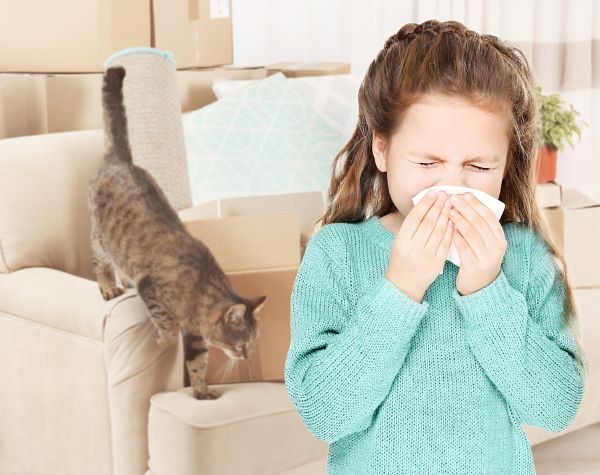Updated on October 30, 2024
Roughly 26 million Americans are affected by asthma or asthma-related conditions. Combined with those who suffer from seasonal allergies, the numbers are even higher. To improve their respiratory health many people head indoors for cleaner air. But inside air can often be as unhealthy as outside air, posing serious health risks for children, seniors and people with asthma and allergies.
One of the most effective ways to improve your home’s indoor air quality and reduce asthma and allergy symptoms is by sealing your home’s air leaks with air sealing.
How Air Sealing Improves Indoor Air Quality

Simply shutting your doors or windows won’t completely keep outside air from entering your home. Air enters and exits your home in a variety of ways. Air can infiltrate through tiny cracks and small openings, naturally ventilate through open doors and windows, or be filtered through an outdoor-vented fan or air handling system.
In the lungs of asthma sufferers, airways become irritated and more sensitive when pollen, dust, mold, and more impact them. These same asthma triggers affect allergy sufferers too.
Sealing a home’s air leaks can help improve indoor air quality by lowering the number of outside asthma triggers that can enter the inside of your home. By sealing air leaks and adding proper mechanical ventilation, your home’s indoor air quality can be managed, and asthma and allergy sufferers can find some relief.
How Air Sealing Improves Energy Efficiency
Air sealing can also improve your home’s energy efficiency. Air leakage wastes money and increases your energy bills by forcing your HVAC system to work overtime to keep your home comfortable. Small air leaks can create as energy inefficient of a home as permanently leaving a window open.
A home needs both insulation and air sealing to truly be energy efficient. When you combine home insulation and air sealing you can take advantage of the maximum benefits of an energy efficient home. Enjoy improved comfort, lower energy bills with savings up to 15%, and minimized moisture problems and mold growth to maintain your home’s stability. Many states offer rebates for improving your home’s energy efficiency, so be sure to check out what offers you might qualify for in Florida or Georgia.
The Air Sealing Process
 Air sealing fills in the small cracks, gaps, and openings throughout your home to create an airtight structure. Air leaks can be found anywhere, from around poorly sealed doors and windows to holes around piping, wiring, and lighting. Many leaks are hard to find and require a trained eye to locate. A majority of air leaks are found in your home’s attic (where heat rises and exits through small gaps), and foundation (where gaps form as your house settles).
Air sealing fills in the small cracks, gaps, and openings throughout your home to create an airtight structure. Air leaks can be found anywhere, from around poorly sealed doors and windows to holes around piping, wiring, and lighting. Many leaks are hard to find and require a trained eye to locate. A majority of air leaks are found in your home’s attic (where heat rises and exits through small gaps), and foundation (where gaps form as your house settles).
Spray foam insulation is a great option to both insulate and seal air leaks in one step. It:
- Provides an exceptional air seal.
- Works as a thermal barrier (insulator).
- Helps control moisture issues and control indoor humidity, which reduces mold.
- Dramatically reduces the number of outdoor air pollutants that can enter your home (pollen, dust, mold, etc.).
- Allows for proper mechanical ventilation to filter the air and keep the interior air clean.
Air sealing is highly technical, time-consuming work best done by professionals. If the job is done incorrectly, you’ll have wasted both time and money. Undergo a professional home energy audit before air sealing to make sure you identify and seal every leak.
Ventilation and Air Quality Systems
Many people choose to utilize multiple ways to help clean the indoor air around them and to complement air sealing and insulation. These methods can include:
- Ventilation systems — They keep air moving and prevent pollutants, bacteria, and viruses from building up or spreading inside your home, as well as managing the temperature to reduce the chance of mold growth. Without proper ventilation, indoor pollutant levels can increase. Ventilation systems include natural ventilation (opening a window or door), mechanical ventilation (using an outdoor-vented fan filter air or using an air handling system), and hybrid ventilation (a combination of natural and mechanical ventilation).
- Air purifiers — Used to filter pollutants or allergens from the air in your home, they use a filter to capture fine particles of pollutants and allergens and then circulate clean air back into the room. Air purifiers may help those with asthma and allergies to a degree, but they can’t eliminate all indoor air pollutants. It’s best to strive to eliminate the sources of environmental triggers.
- HVAC maintenance — Maintain your HVAC system to keep it clean of dust and pollutants and running smoothly. Stay up to date on system maintenance and change your air filter often as it traps air borne pollutants.
Environmental Triggers and Asthma and Allergy Management
A wide variety of things can trigger asthma and allergy symptoms. Environmental triggers, health conditions, physical activity, weather, strong emotions, and even some medicines can affect those with asthma.
Minimizing or eliminating these triggers is vital to keeping symptoms under control. Air sealing prevents polluted outdoor air from entering your home and is the most effective choice for improving your indoor air quality.
Complement air sealing by taking everyday steps to control the allergens and irritants in your home such as controlling dust mites by keeping things clean and uncluttered, vacuuming once or twice a week, reducing humidity to avoid mold spores, and controlling bugs.
Breathe Easier with Quality Air Sealing
We’ve explored how air sealing can improve your indoor air quality and reduce the likelihood of asthma and allergy symptoms. You can breathe easier knowing air sealing not only keeps outdoor pollutants like mold spores, dust, and pollen from entering your home but also improves your home’s energy efficiency too. We’re here to help you take the first step towards a healthier home environment. Contact Allweather Insulation in Tallahassee today for a free consultation.


